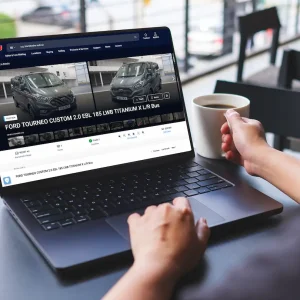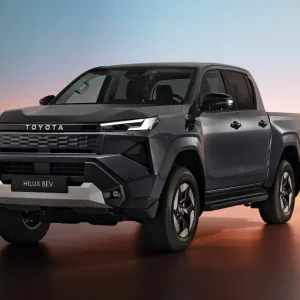The first fully manufacturer- developed and built electric light commercial vehicle launches this month in the form of Renault’s Kangoo ZE, and the initial verdict is that in many ways it’s a relaxing non-event of an experience to drive. That’s far from a criticism though, because the hop-in-and-drive nature of the electric vehicle is key to its acceptance. This is no space-aged technology, and in many ways it’s just like driving an automatic van. Silently.
But let’s get the basics out of the way first. The Renault Kangoo ZE is the first of four Renault electric vehicles launching in the next 12 months, the other three being passenger cars. It comes in three forms: basic van for £16,990, Maxi van for £17,990 and five-seat crew van, driven here, for £18,690. That’s to buy the vehicle, but not the battery itself, which Renault is insisting the customer leases over various time and distance equations (see ‘Battery Powered’, opposite page), the reasoning being that the manufacturer then takes the risk on the new technology. It is, though, a shame that there’s no option for a company or individual to own the vehicle outright, and some industry commentators, particularly residual value expert Cap, have been critical of the potential complications of this method of sale.
To look at, the ZE version of the Kangoo is exactly the same as the standard internal combustion- engined version already on-sale. The only major differences are what looks like a fuel flap in the front, where the plug to recharge the ZE is located, the lack of an exhaust pipe, and the ZE decals on the side and rear.
As far as the numbers go, the range is put at 106 miles on the official European test cycle, which Renault claims will suit the 70% of van drivers that cover less than 60 miles per day. The firm says the electric vehicle is at its most efficient in cities, when the regenerative braking – where the battery recoups energy under deceleration – can add to the range by at least 20 miles. In contrast, Renault admits sporty driving, hills and use of the air- conditioning can lead to a range of less than 50 miles. The battery can be recharged in six-to-eight hours using a standard three-pin socket, but Renault recommends installing a specific charging station, which can cost around £1000. Power comes from a 44kW electric motor that is equivalent to around 60hp.
Turn the Kangoo ZE key and the only signal that anything has changed is the big green ‘Go’ that lights up on the dashboard. Drop the automatic gear lever into ‘Drive’, as you would with any auto, and off you go. Without any noise at all. Which in itself takes a bit of getting used to, and drivers have to allow for pedestrians and cyclist having no idea the Kangoo ZE is bearing down on them, particularly at low speed, such as in pedestrianised zones. On our test route we had to take avoiding action to skirt round a pedestrian stood in the middle of the road with his back to us, oblivious to the van heading straight for him. There will be an optional noise feature for all Renault’s EVs that operate at below around 20mph, to avoid sneaking up on the unwary, vulnerable road user.
The other thing that takes some getting used to is the regenerative braking. It can collect enough energy to significantly extend the vehicle’s range, but is so aggressive with its function that it almost completely negates the need for a brake pedal under all but the most emergency of braking situations. As soon as you come off the accelerator pedal the vehicle is instantly slowing, and intelligent anticipation of traffic movements could potentially lead to the brake pedal not being touched across a day’s work. Once drivers have adapted it’s fine, but it is a little disconcerting at first thanks to the rate of deceleration, and won’t be helpful in situations such as a courier company cruising up a suburban street looking for a particular address. You’re either on the accelerator or braking when driving the Kangoo ZE, there’s no in between.
But otherwise, there’s absolutely nothing to be afraid of in driving electric vehicles.
Although it’s the equivalent of a 60hp engine, the ZE feels much quicker thanks to the almost instantaneous power delivery that makes ducking into gaps in city traffic much easier than fishing for a lower gear and then doing the same in a diesel van. Even at higher speeds there’s no issue keeping up with traffic, although longer runs have a significant impact on battery life.
It’s actually a far more relaxing experience to drive the ZE compared with a diesel, with the silent running proving rather therapeutic. 
But in some ways it’s too much like the internal combustion-engined version. While there’s a large battery-level indicator and on the small dash display it’s possible to access a range indicator, there’s no clever innovation screen illustrating battery regeneration levels. This is down to Renault adapting an existing internal combustion vehicle rather than building an EV from scratch, but that’s likely to be rectified in future generations of Kangoo ZE. There is a needle swinging from blue to red depending on acceleration or braking, but it’s not enough to really educate the driver on how their behaviour can lengthen or shorten the vehicle’s range.
Apart from that, it’s pretty much the same as any other Kangoo. Load space is the same as the standard van, as the batteries are all packaged under the floor, and a 650kg payload is also the same as the conventional model.
The Kangoo EV makes a massive amount of sense for some businesses, and none at all for others. If range is going to be an issue, then an electric vehicle is clearly inappropriate, but if vehicles are doing set routes of less than 60 or 70 miles, and coming back to somewhere that they can easily be recharged overnight, then it’s well worth a look.
Renault isn’t limited by supply because the ZE comes down the same line as the standard Kangoo at the MCA plant in northern France, and while the list price is higher, for many operators the total cost of ownership may be closer than it looks to diesel vans. Renault’s own insurance company is set to offer insurance premiums 20% lower than for a diesel Kangoo, mainly because of the lower mileages the EV will cover, and servicing will also be around 20% cheaper as there are fewer moving parts and no need to change oil, filters and timing chains. Plus, the monthly lease rate for the battery is likely to be less than the cost of a tank of diesel, even allowing for a couple of pounds of electricity to recharge. Renault has also extended the standard vehicle recovery offered with the Kangoo to include running out of charge, which it won’t do for free if a vehicle runs out of diesel, taking a Kangoo EV to a charging point of the driver’s choosing within 50 miles.
The electric Renault Kangoo is an impressive game-changer in many respects. It won’t suit every need, and it is more expensive to buy than a diesel light van, but in the right circumstances it could have an impact in terms of environment, emissions, running costs and public relations for firms with an eco stance. It feels like a more complete and integrated vehicle than the rival models that use existing LCVs and effectively aftermarket adapt them, and the impressive purchase price for the ZE should lead to a degree of deserved success. It’s not going to take over the world overnight, and there is still a long way to go to find a solution to suit every LCV requirement, but the Kangoo ZE is a promising first step that is a genuinely feasible and logical van for many business needs.
Battery powered
Renault has elected to separate its electric vehicles from the batteries that power them, with owners buying the vehicle ‘shell’, but not the battery that propels it. That element will be leased from Renault, as the company guarantees the battery performance and operation, and takes over the risk for what is the new and unproven technology.
Renault has a choice of 20 leasing options, covering one- to five-year leases of 6000, 9000, 12,000 or 15,000 miles per year. The cheapest options are three-, four- or five-year 6000-mile per annum agreements at £60 per month, and the most expensive is a 12-month, 15,000-mile arrangement at £105 per month, all excluding VAT.
The arrangement includes guarantee of a battery that’s always operating at no less than 75% of its original charge capacity, which is important as some industry commentators have aired concerns that batteries will degrade over time in terms of their ability to hold a full charge, impacting upon range.
Verdict
Not only proves that electric vehicles are nothing to fear, but also that they can actually be a sensible, cost-efficient addition to a business.





